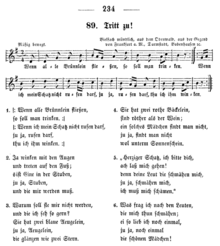Repetition mark (musical notation)
The repeat sign is a symbol in musical notation .
It has the form of a closing stroke with two points on the side, a repetition of one or more in the direction of clocks is required.
In this case the first measure would be played twice. Normally, no repeat symbol is set at the beginning of a piece of music if it should be repeated from the beginning.
In the event that only part of a piece is to be repeated, a repeat symbol (pointing to the right) must also be placed in front of the first measure of the part to be repeated. Volten brackets (also: brackets , house ) are used when one or more bars at the end of the repetition part are to be skipped after repetition or replaced by a different bar. This results in a clear sequence for the following notation:

In many songbooks , repeat symbols are also used in the text stanzas to indicate repeated passages in the text.
Repetitions, mostly related to larger sections, can also be indicated by Da capo and Dal Segno .
Representation in computer systems
In the Unicode musical notation block of the international Unicode character coding system , the left repeat character is in position U + 1D106 ("Musical Symbol Left Repeat Sign"), the right one in U + 1D107 ("Musical Symbol Right Repeat Sign").

